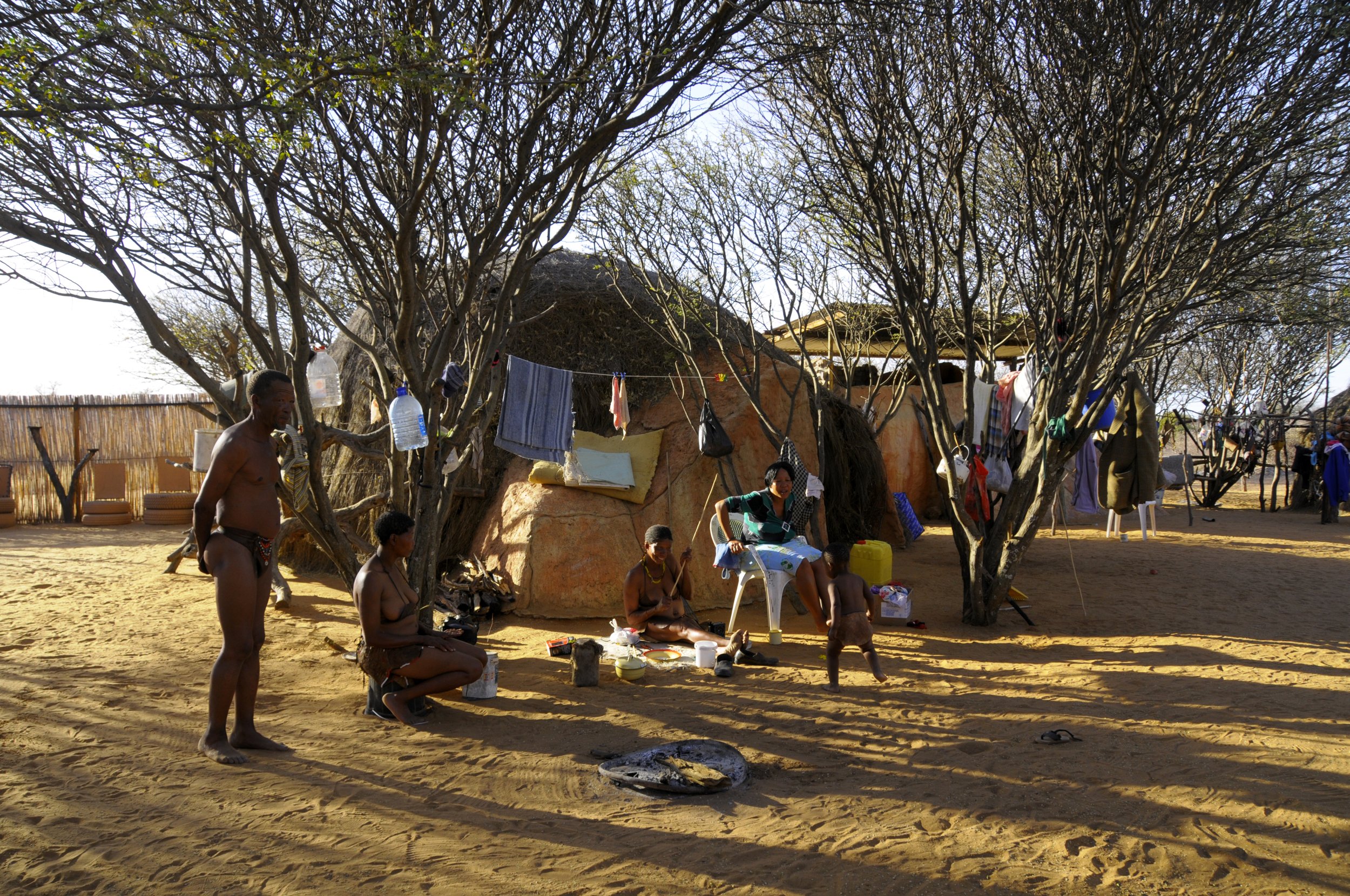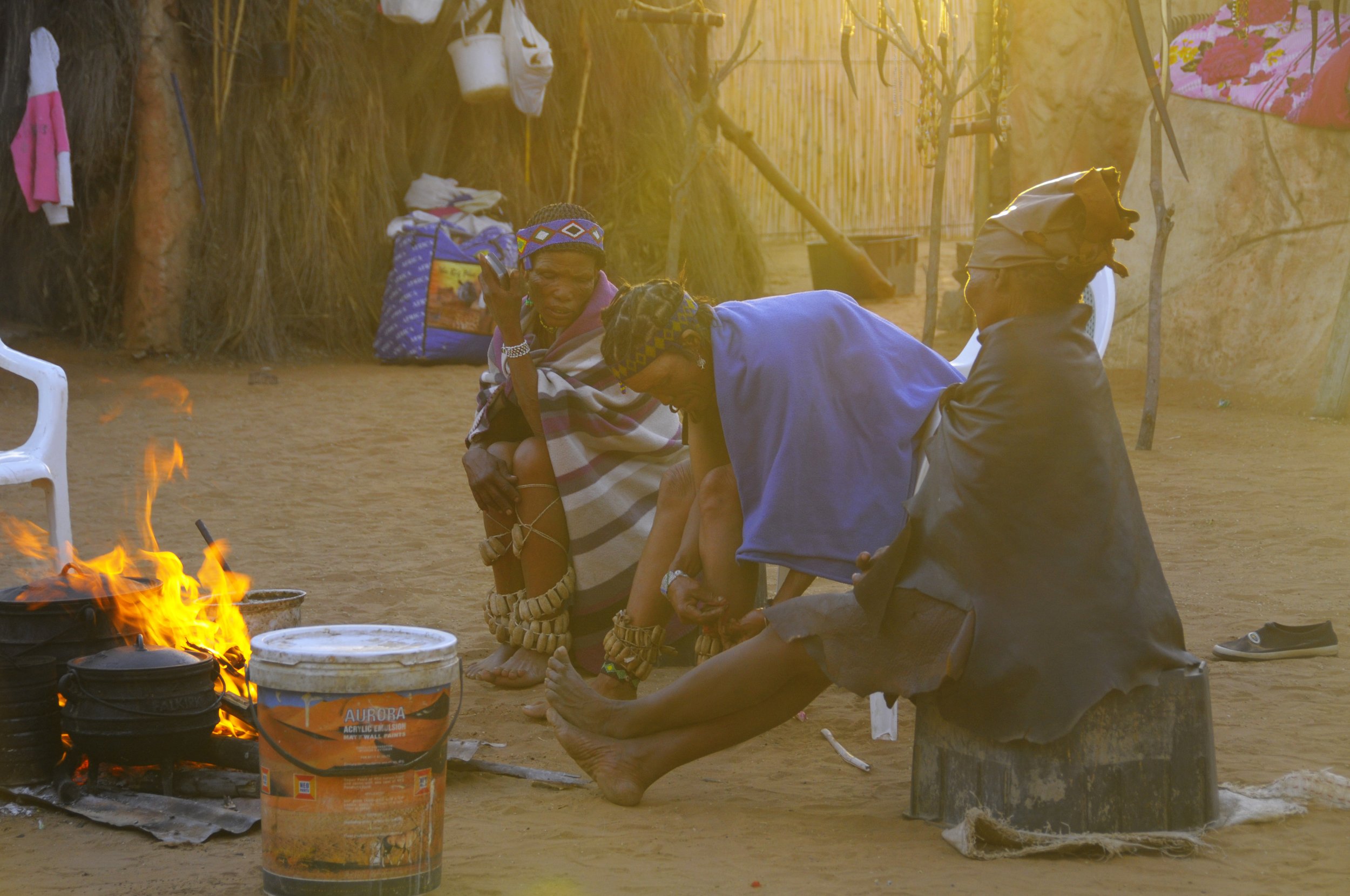THE SAN PEOPLE - LIVING LEGENDS OF A DYING CULTURE
Melding stone-age traditions with modern conveniences
The San Bushman culture and way of life is on the verge of extinction. What were once thousands of San people, are now only hundreds. Today the San are struggling to find their way in the twenty-first century.
“Can the San people successfully protect their core traditions under the onslaught of modern civilization?”
A San man during a bush walk collecting medicinal plants
Throughout history conflicts have arisen when ancient cultures collided with more modern societies. Many ancient cultures such as the indigenous tribes in North America have almost disappeared under the onslaught. Others try to turn their backs on modern culture, in a desperate attempt to maintain their ancient traditions. In Southern African the San people are trying to find a way to take what is useful from modern culture while still passing on their most important core beliefs and traditions to their children.
The San people are believed to be the oldest indigenous inhabitants of Southern Africa having inhabited the region for as many of 60,000 years with a way of life that’s changed little over the last millennia. They are hunter-gatherer people. Indeed their name, “San” derives from the word Sonqua which means those without cattle. They are also known as bushmen, Basarwa, Kung or Khwe, Khoisan or the children of nature. Their home was the vast expanse of the . By the end of the 19th century, they had been pushed into the Kalahari desert region by Europeans and Africans arriving in southern Africa and commandeering the more fertile land for themselves. They became desert experts and continued to eke out livings in the most arid regions. Today the San are struggling to find their way in the twenty-first century. Great are the attractions of the modern world. But many of them are seeking ways to maintain the essence of their culture.
I set out under clear skies and a bright sun, didn’t know what to expect as we drove along the bumpy roads. The driver suddenly took a right turn and went off the road, we drove in a bit and there in front of me was something that looked like an gate of sorts made from twigs. I was anxious to meet the San. I got out of the car, got my bags and walked to the gate. As we entered the village, my eyes slowly swept over the scene unfolding before me. We were standing in a clearing, with a few huts and half barren trees. An elderly man, smiling enthusiastically welcomed us. He began to speak to us using the clicking noises; which make their language, called Khoekhoe. It was fascinating to listen to. As I walked in I noticed there were women making jewelry outside their huts and lots of kids running around playing and laughing. I saw a lot of traditional things and some modern things too.
The children were curious but shy in the beginning. Soon they all came running to greet us smiling, and laughing wanting us to play with them. They wanted to touch my skin as I looked like them but wasn’t San.. They turned out to be normal, friendly, adorable children even though we didn’t speak the same language.
I played with the children for a bit then wandered around watching what some of the elders were doing. One of the women was making beads from Ostrich egg shells by breaking away the parts that she didn’t want to make an almost perfect circle out of the shell with a tiny hole in the center of the bead just big enough for a strand of grass to pass through. One of the men was making an arrow head from bone with great precision. They were very eager to show me how they worked and invited me to come and sit with them while they worked.
A SAN VILLAGE IN NAMIBIA
A SAN WOMAN MAKING JEWELLERY OUT OF OSTRICH EGG SHELLS
SAN WOMEN SITTING SROUND THE FIRE AND WARMING UP
San Family sitting around the fire before their deer dance
Later as the sun set, they prepared themselves to experience the healing dance with us. The women sit around the fire in a circle, sing and clap their hands as the men amongst the group dance around them. Around their ankles the men wear rattles, which are cleverly crafted from dried seed pods and their traditional outfit; the women wear a blanket made of leather and some jewelry. Their energy and laughter is whats really to who they are as a group. The healing dance as a beautiful rhythmic drumming of feet, clapping of hands and click-like chants which is an ancestral sound. The kids follow in their father’s footsteps with guidance to keep this almost dying tradition alive into the future, knowing it lies in their hands while the babies stay nestled in their mothers arms. It is an ancient rhythm which forces all hair on the back of your neck to rise. As the dancing ritual drives on further into the night, the women’s calling sound increases in speed and intensifies which is meant to indicate that the men are being sent into a trance. This is a part of the “healing” or “medicine” dance routine. Its hard not to get lost in thought with the flow of the heavy, beating music taking you time traveling to their lives in the ancient world.
THE SAN DEER DANCE
When they went into the bush, they wore their traditional outfits made of skins. They carried hide slings, hide cloaks; called a Kaross, to carry their gatherings, digging sticks, arrows and spears made from wood and bone using them for foraging their daily diet which is mostly fruits, nuts, berries, and roots for medicinal supplies which they seek out in the desert. It was a glimpse into how these real life hunter-gatherers adapted to the Kalahari Desert many thousands of years ago through these skills.
A SAN MAN DIGGING THE GROUND TO GATHER A ROOT FOR WATER
The Kalahari San people are deeply rooted in their ancient culture and in their symbiotic relationship with the animals, birds and plants of the desert.
The San people walk in lines to reduce their impact on the fragile vegetation in the desert. One of their most important skills that helps them survive in their inhospitable land, is the ability to identify areas that have tubers deep down which provide water to quench one’s thirst. They are also skilled in coiling grass and vines to make ropes. They are experts in the medicinal and culinary uses of all the plants that survive in the desert around them.
A SAN BABY
A SAN BOY OUT ON A BUSH WALK LEARNING FROM HIS ELDERS
Now hunting is extremely restricted, but in the past hunting played an important role in providing protein in their diet. Poisoned arrows were made by applying a poison paste on the arrowhead for hunting.
Visiting them in their village and participating in the daily routines made it clear to me that the San are working to maintain the essential elements of their ancient culture and beliefs while adapting modern conveniences that make their lives more comfortable. The elders stay in a traditional style village and pass on their core beliefs and traditions to their grandchildren. The parents seek employment in the nearby towns and the grandchildren go by truck to the nearest school daily. Even in the village many of them have happily adopted wearing faded western clothes and warm jackets, using modern steel utensils and plastic barrels and chairs because they make their lives more comfortable. However, they communicate with each other in their traditional khoikhoi language, teach the children their rituals and dances, and show the children how to find, use and protect useful plants and tubers in the surrounding desert.
For me it was a unique opportunity to witness the knowledge and skills of the San people. They are very beautiful, friendly, people and are taking a pragmatic approach to preserving their important traditions while adopting some modern tools and clothes which are more practical. They work outside and send the children to school, but they are trying to maintain important traditions like their family ties, dance and language. The experience of the ancient lifestyle was intense and beautiful. What will happen to these people and their way of life in the future?
Modern society is very alluring with its offers of comforts and entertainment.
“Will the San culture perish? Or will these gentle, hospitable people draw on their steely core which allowed them to survive in the harsh desert region for centuries and find a way to preserve what is most precious in their traditions while taking what is most useful from modern society?”























